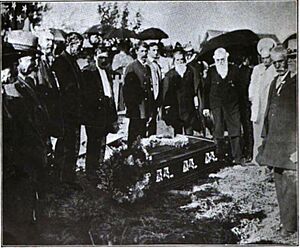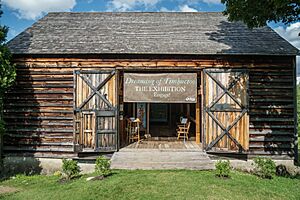John Brown Farm State Historic Site facts for kids
|
John Brown Farm State Historic Site
|
|

John Brown's house
|
|
| Lua error in Module:Location_map at line 416: Malformed coordinates value. | |
| Nearest city | Lake Placid, New York |
|---|---|
| Area | 270 acres (110 ha) |
| Built | 1855 |
| NRHP reference No. | 72000840 |
Quick facts for kids Significant dates |
|
| Added to NRHP | June 19, 1972 |
| Designated NHL | August 6, 1998 |
The John Brown Farm State Historic Site is a special place in North Elba, New York. It was once the home of John Brown, a famous abolitionist. An abolitionist was someone who worked to end slavery in the United States. This farm is also where John Brown was buried after he died.
John Brown moved to this area in 1849. He wanted to teach farming to African Americans. The farm is about 3 miles (5 km) southeast of Lake Placid, New York. It's in the beautiful but often cold Adirondack Mountains. People have called it one of the highest farms in the state.
Visitors in the past were amazed by the views. They saw towering mountains, peaceful valleys, and clear lakes. It's a place that makes you feel small next to nature's grandeur. The weather here can be very cold, even for six months of the year!
This farm became a National Historic Landmark in 1998. The state of New York has taken care of it since 1896. You can visit the grounds all year round. Tours of the house are available during the warmer months.
Contents
John Brown's First Home in North Elba
When John Brown first came to the Adirondacks in 1849, the town of North Elba was new. The farmhouse you see today hadn't been built yet. North Elba officially became its own town in 1850.
John Brown and his family first rented a small house from a man named "Cone" Flanders. His daughter, Ruth, described it as having one main room downstairs. This room was used for cooking, eating, and as a living area. It also had a pantry and two bedrooms. The attic had space for four more beds.
This small house was home to John and his wife, five sons, and three daughters. They also had helpers and sometimes guests. They lived there for two years. Then, John Brown moved his family to Akron, Ohio, for his wool business. The Flanders house later burned down in the 1900s.
John Brown was also a farmer. In 1850, he showed his amazing Devon cattle at the Essex County Fair. People were very impressed by his beautiful animals. They thanked him for bringing such great livestock to the fair.
In 1855, John Brown and his family returned to North Elba. This is when they built the farmhouse that still stands today.
A Safe Place for His Family
John Brown didn't live at the farm for long periods himself. He saw it as a safe haven for his wife and younger children. He wanted them to be secure while he and his older sons were away. They were fighting against slavery in Kansas.
A local historian said the farm was a good refuge. It was a place where his family could be independent and live simply. Brown believed in teaching his children to be hardworking and thrifty. In 1859, John's son Salmon, who was 23, was in charge of running the farm.
Exploring the John Brown Farm
We know a lot about John Brown's farm from 1859. Reporters and artists visited for his funeral. A minister named Joshua Young also wrote a detailed description. Other visitors in the 1860s shared what they saw.
The John Brown Farm is on John Brown Road. It's south of the modern village of Lake Placid. It was about 2 miles (3.2 km) from Timbuctoo, New York. This was a community of Black farmers whom Brown tried to help. The property today is 270 acres (109 ha).
Today, the farm has John Brown's farmhouse and barn. The barn has an exhibit called "Dreaming of Timbuctoo." There's also a caretaker's house and other things for visitors. In 1859, the house was described as a simple, two-story frame building. It had four rooms downstairs and space upstairs.
One visitor in 1859 described the amazing view from the front door. They saw the rugged Adirondack Mountains in front. To the left was Whiteface Mountain, named for its light-colored rock. The Saranac and Ausable rivers flow nearby. Lake Placid was also visible, known for its beauty.
The family graveyard is part of the site. It's surrounded by a modern iron fence. A statue of John Brown by Joseph Pollia stands nearby. It was placed there in 1935.
Farm History
John Brown came to upstate New York as part of a plan by Gerrit Smith. Smith wanted to help Black people own land. Owning land meant they could vote in New York at that time. Smith gave away many 40-acre (16 ha) plots of land in the Adirondacks. (You can learn more about this at Timbuctoo, New York.)
John Brown had lost money in his wool business. He heard Smith was giving away farms. So, he asked for one. He said he knew how to clear land and build a farm. He also offered to teach these skills to the Black farmers. Brown never actually paid Smith for the land. His friends later collected money to pay for it.
The Timbuctoo project faced many challenges. It was very cold and isolated. Clearing land and farming was hard work. Most of the Black farmers left within a few years. However, John Brown himself did succeed in building a farm for his family.
John Brown's son-in-law, Henry Thompson, built the house with his own hands. Henry was married to Brown's daughter, Ruth.
John Brown's Funeral and Burial
After John Brown's failed raid at Harpers Ferry, he was executed on December 2, 1859. His wife, Mary, brought his body back to the farm for burial. The funeral took place on December 8. Many people attended, including formerly enslaved Black individuals. Wendell Phillips, a famous speaker, gave a speech. John Brown's favorite hymn, "Blow ye the trumpets, blow!" was sung.
The minister, Joshua Young, read from the Bible. When he returned home, some people were very upset that he had led Brown's funeral. He was forced to leave his job.
Remembering John Brown
On July 4, 1860, over 1,000 people gathered at the farm for a memorial service. John Brown's family was there, along with friends. It was the last time Brown's family would all be together. They rarely spoke publicly about him. His daughter Annie didn't even tell her children they were John Brown's grandchildren. She felt it might make their lives harder.
The Farm Changes Hands
Money was collected to help John Brown's widow, Mary. This allowed her to add a room to the house between 1860 and 1863.
Most of John Brown's family did not stay at the North Elba farm. His sons moved to Ohio or California. Salmon, his son, said the Brown family was "despised bitterly." In 1863, Mary leased the farm to Alexis Hinckley. He was Salmon's wife's brother. In 1865, Hinckley bought the farm from Mary for $800. The grave site was not included in the sale. The deed said that anyone interested could cross the property to visit John Brown's grave.
Saving the Property
By 1864, many tourists were visiting John Brown's grave. It became a special place for people to remember him. In 1870, Alexis Hinckley wanted to move. He sold the farm for $2,000. A journalist named Kate Field bought it. She formed a "John Brown Association" to protect the farm and make it open to visitors.
By 1885, hundreds of people visited the grave each year. By 1894, tens of thousands had visited. The farm was given to the State of New York in 1896. In 1897, President McKinley and other important people came for a dedication ceremony. John Brown's favorite hymn was sung again.
Burial Sites

Three burials have taken place at the John Brown Farm:
- John Brown himself was buried on December 8, 1859. This was right after his execution.
- Watson Brown, one of John Brown's sons, died in 1859. His body was buried here in 1882. His mother brought his body for burial.
- In 1899, the remains of 10 of Brown's raiders were reburied here. This included his son, Oliver Brown. They were placed in one coffin because it was hard to identify them separately.
John Brown's grave has a special stone called a cenotaph. It was originally for his grandfather, who fought in the American Revolution. John Brown moved it to his farm. He had the names of his sons, Frederick, Oliver, and Watson, added to it. This stone is now protected by glass.
Activities at the Farm Today
Since 1922, African-American members of the John Brown Memorial Association have visited the farm every year. They often brought important speakers like Clarence Darrow and A. Philip Randolph.
In 1935, a new statue of John Brown was unveiled. It showed him helping a young Black boy. The statue was paid for by small donations from Black people across the United States. Lyman Epps, Jr., who had attended Brown's original burial as a boy, helped unveil it. The Civilian Conservation Corps (CCC) helped build the statue's base and paths. About 2,000 people attended the event.
After 1970, the annual visits changed. Attendance slowly decreased.
In 1999, a new group called John Brown Lives! started celebrating John Brown Day again.
In 2009, for the 150th anniversary of Brown's raid, a special event was held. It explored the impact of Brown's actions.
Today, the John Brown Farm hosts an annual "Blues at Timbuctoo" festival. This festival combines blues music with discussions about race relations. It started in 2015.
In 2016, the "Dreaming of Timbuctoo" exhibition found a permanent home in the barn. It tells the story of the Black farming community Brown tried to help.
In 2017, students from the State University of New York at Potsdam searched the site for old artifacts. They hoped to find items linked to John Brown.
Gallery
See also









